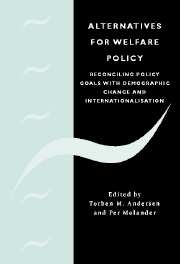Book contents
- Frontmatter
- Contents
- List of contributors
- Preface
- 1 Introduction
- 2 International integration and the welfare state
- 3 The changing age structure and the public sector
- 4 Emigration from the Scandinavian welfare states
- 5 Productivity and costs in public production of services
- 6 Use of fees in the provision of public services in OECD countries
- 7 Privatisation of social insurance with reference to Sweden
- 8 Occupational welfare
- 9 Pathways to retirement and retirement incentives in Sweden
- 10 Social insurance and redistribution
- 11 Assessing the effect of introducing welfare accounts in Sweden
- 12 Taxation in a global economy
- 13 Taxation and education investment in the tertiary sector
- 14 Debt strategies for Sweden and Europe
- 15 Policy options for reforming the welfare state
- Index
- References
4 - Emigration from the Scandinavian welfare states
Published online by Cambridge University Press: 22 September 2009
- Frontmatter
- Contents
- List of contributors
- Preface
- 1 Introduction
- 2 International integration and the welfare state
- 3 The changing age structure and the public sector
- 4 Emigration from the Scandinavian welfare states
- 5 Productivity and costs in public production of services
- 6 Use of fees in the provision of public services in OECD countries
- 7 Privatisation of social insurance with reference to Sweden
- 8 Occupational welfare
- 9 Pathways to retirement and retirement incentives in Sweden
- 10 Social insurance and redistribution
- 11 Assessing the effect of introducing welfare accounts in Sweden
- 12 Taxation in a global economy
- 13 Taxation and education investment in the tertiary sector
- 14 Debt strategies for Sweden and Europe
- 15 Policy options for reforming the welfare state
- Index
- References
Summary
Introduction
The topic of this chapter is the challenge international mobility, both emigration and immigration, poses to the Scandinavian welfare states. Earlier contributions have mainly discussed issues related to immigration from low-income countries. We turn the focus mainly on to the emigration and return migration of Scandinavians from a ‘brain gain or drain’ point of view. Thus, a specific object of interest is the selection pattern, that is, the distribution of human capital and (earning) abilities in the emigrant and return migrant groups compared to the distribution of these variables in the populations of the Scandinavian countries.
Labour market institutions and welfare systems vary among countries, including within the Scandinavian region. There are, however, a number of similarities in the Scandinavian systems that may have some relevance regarding international mobility. Compared to other countries, the Scandinavian labour markets are characterised by high participation rates (for both women and men), high employment rates, low variance and high mean values in the wage distribution and strong emphasis on active labour market policies. Especially in the lower part of the wage distribution unemployment insurance benefits are generous. Further, the labour markets are highly organised and the minimum wage is high, i.e., fairly close to the average wage. The Scandinavian welfare state model is characterised by very comprehensive eligibility for most benefits. Some benefit programmes depend on domestic labour market experience, but all residents are eligible for welfare benefits should they be unable to provide for themselves.
- Type
- Chapter
- Information
- Alternatives for Welfare PolicyCoping with Internationalisation and Demographic Change, pp. 76 - 104Publisher: Cambridge University PressPrint publication year: 2003
References
- 7
- Cited by



